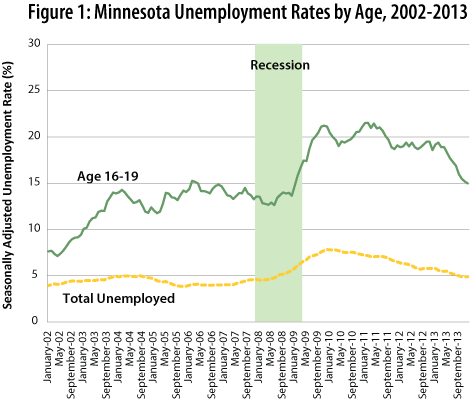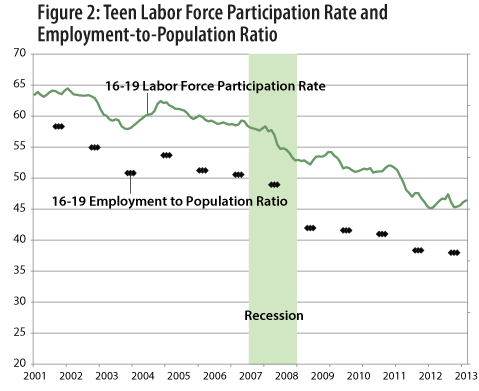by Nick Dobbins
March 2014
Heading into the summer of 2014, teen job-seekers in Minnesota are faced with a slowly improving employment picture. As we continue our recovery from the 2009 recession, the labor market for young Minnesotans and for the workforce at large retains its share of challenges. However, as with the employment picture overall, the outlook for teen employment continues to improve over recent summers.
As Figure 1 shows, although the teen unemployment rate is still higher than it had been pre-recession, 2013 saw a dramatic decline in unemployment over previous years. For the summer months, for our purposes, July, August, and September, the average unemployment rate for Minnesota workers age 16 to 19 dropped from 18.9 percent in 2012 to 16.7 percent in 2013. Not only did the rate fall, but the gap between the unemployment rates for teens and the entire workforce tightened as well. In difficult labor markets young and inexperienced workers are more likely to be shut out of the workforce than older workers. In Minnesota the teen unemployment rate had been hovering between 11.3 and 14.4 points higher than the overall rate since the summer of 2009, when the recession drove unemployment rates to recent highs. At the end of 2012 there was a difference of 12.8 percent between the two rates. By December 2013, however, the teen unemployment rate was only 10.1 points higher than the overall rate. While teen unemployment rates tend to be slightly higher than the overall rate even in good job markets, and the gap appears to be shrinking, the disparity remains higher than historical averages.

While the unemployment rate for Minnesotans age 16-19 shows encouraging movement over the last two years, that improvement is balanced somewhat by a continued decline in participation in the labor market by the same age group. As Figure 2 shows, 2013 continued a trend of declining labor force participation rates and employment-to-population ratios that have been dropping since before the recession. This is mirrored by a smaller but no less consistent decrease in the overall labor force participation rate. Where teen participation in the labor force has dropped by 17.5 percent since the beginning of 2002, the overall rate has fallen 6 percent over the same time period. However, these declines do not necessarily share the same causes.

Teens in Minnesota work in every field, although they tend to congregate around a handful of specific industries that best match their qualifications, availability, and desired work environments. Of a total of 88,545 Minnesotans age 14 to 18 who were working in the summer of 2012, 72,666 or 82 percent, are accounted for in the seven industries listed in Table 1. Two industries in particular, Accommodation and Food Service and Retail Trade, account for 50,843. That represents 57% of all workers in the age group.
As Table 1 illustrates, teen summer employment overall has shown improvement in recent summers, suggesting a gradual strengthening of the job market. That improvement has largely been driven by the two biggest industries for teen workers, Accommodation and Food Service and Retail Trade. While the recent trend is one of increasing summer employment for 14-18 year-olds, note that they are still well off the 2007 pre-recession employment levels. Also note that teen workers earned less money in the summer of 2012 than they had the previous year, although it is unclear if this decline was caused primarily by lower wages, fewer hours worked in the month, or some combination of those factors.
| Teen (Age 14-18) Employment Data Comparison, Minnesota:
Summer 2007, 2010, 2011, 2012* |
||||||||||
|---|---|---|---|---|---|---|---|---|---|---|
| Sector | Number Employed | Average Monthly Earnings | ||||||||
| Summer 2007 | Summer 2010 | Summer 2011 | Summer 2012 | Percent Change 2011-2012 | Summer 2007 | Summer 2010 | Summer 2011 | Summer 2012 | Percent Change 2011-2012 | |
| All Sectors | 121,382 | 83,132 | 84,127 | 88,545 | 5.3% | $631 | $643 | $680 | $665 | -2.2% |
| Accommodation and Food Service | 38,729 | 29,366 | 29,447 | 30,751 | 4.4% | $562 | $559 | $588 | $589 | 0.2% |
| Retail Trade | 32,329 | 19,267 | 19,407 | 20,092 | 3.5% | $584 | $572 | $607 | $599 | -1.3% |
| Health Care and Social Assistance | 7,907 | 6,121 | 5,978 | 5,896 | -1.3% | $710 | $717 | $757 | $740 | -2.2% |
| Arts, Entertainment, and Recreation | 6,093 | 4,600 | 4,567 | 5,717 | 25.2% | $530 | $466 | $532 | $503 | -5.5% |
| Other Services | 4,892 | 3,514 | 3,485 | 3,426 | -1.7% | $526 | $510 | $538 | $515 | 4.3% |
| Public Administration | 4,663 | 3,389 | 3,384 | 4,128 | 22.0% | $443 | $422 | $431 | $429 | -0.5% |
| Manufacturing | 4,035 | 2,327 | 2,470 | 2,656 | 7.5% | $1,163 | $1,334 | $1,510 | $1,336 | -11.5% |
| *Third quarter data for each year | ||||||||||
| Source: U.S. Census Bureau, Longitudinal Employer-Household Dynamics, Quarterly Workforce Indicators for Minnesota. | ||||||||||
Minimum wage laws affect teens at a higher rate than any other age group in the country. According to the Bureau of Labor Statistics, in 2012, 21.1 percent of workers age 16 to 19 were paid at or below the federal minimum wage, compared to 4.7 percent of all workers. Workers under the age of 24 made up 55 percent of all people who were paid at or below the current minimum, although they represented less than 20 percent of people who were paid an hourly wage.1
Because they are largely unskilled and just beginning their lives in the workforce, teen workers are affected disproportionally by the minimum wage level. This means that the recently passed increase in Minnesota's minimum wage, as well as the changes under consideration at the federal level, could cause outsized changes in the labor market for younger workers. The effect this will have on the labor market are somewhat uncertain, but what we know for sure is that workers making the minimum wage will see their hourly pay climb to $8 an hour in August and eventually to $9.50 an hour in 2016. This is sure to mean increased wages for many teens and could help teenage workers in general earn more money than they have in the past. However, there are concerns that the mandated increase could also have adverse effects on the labor market, for instance by causing employers to hire fewer workers, or to lower the number of hours they allow employees to work, which could limit the benefits of higher wages. For those interested in teen employment, it's an issue to follow as the new law is instituted.
The importance of finding a good job as a teenager can vary greatly from person to person. While many young people pursue internships, college, volunteer work, or other activities in lieu of employment, the ability to find a job can be critical for many teens. Many of the teenagers who seek employment have recently completed their high school education and are preparing to enter the workforce and begin supporting themselves financially. For those people, not finding a job can have negative repercussions that follow them for the rest of their lives.
One study has estimated the financial cost of the estimated 6.7 million 16 to 24 year olds in America who were neither working nor attending school at the time of the study to be $1.6 trillion2 over the course of their lives. The Economic Policy Institute, which has studied the issue of graduates entering the job market during the recession, estimates that current grads could see their earnings suffer for 10 to 15 years simply because they are entering the labor market at an inopportune time3.
While the exact impact is hard to quantify, the potential benefits of being employed as a teenager are plentiful. From learning how to search and interview for a job, to developing the necessary work skills, resume building, job contacts, and the money in their pockets, summer jobs can offer teens a number of advantages whether they intend join the workforce permanently or leave their jobs to continue their education at some point in the future.
There are a variety of resources and organizations aimed at helping teens navigate the job market. Many have a specific focus, such as woodworking, agriculture, or business. In addition to the selected programs listed below, DEED provides multiple avenues of assistance for youth who come from low-income families or have barriers to employment. The MN Youth Program, Youthbuild Program, and Workforce Investment Act Youth Programs all provide services to youth who are seeking employment. You can find more information on these programs, including lists of service providers, searchable by county.
If you're a youth looking to join the workforce yourself, you can also improve your chances by having a well written resume that has been proofread by at least one additional person, by finding as many references as possible from people you know already in the workforce, and by being sure to pursue whatever opportunities you're able to find. While it may be more difficult to find a job in the current market, being successful this summer may make a big difference in your work life later on.
This is a partial list of Minnesota youth employment programs and services. Many available opportunities are not listed here so please do your own research on what may be available in your community.
1U.S Department of Labor, Bureau of Labor Statistics, February 26, 2013. "Characteristics of Minimum Wage Workers: 2012."
2Shierholz, Heidi, Natalie Sabadish and Nicholas Finio. April 10, 2013. Economic Policy Institute, Briefing Paper #360. Page 2.
3Belfield, Clive R., Henry M. Levin and Rachel Rosen. January 2012. "The Economic Value of Opportunity Youth" Page 26.